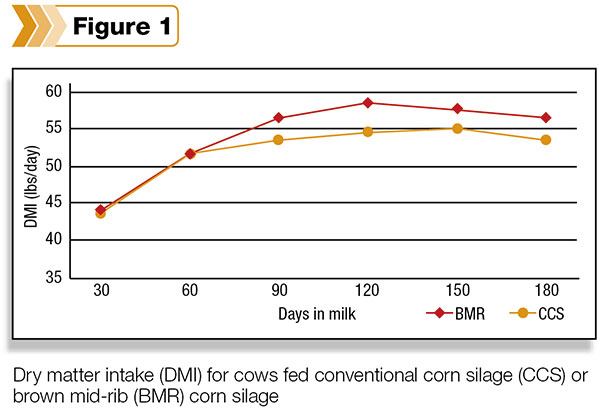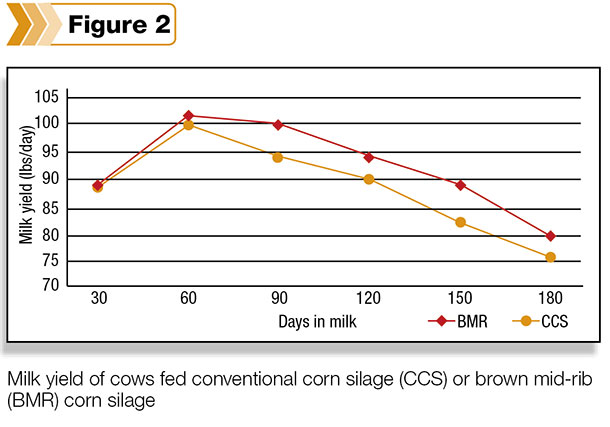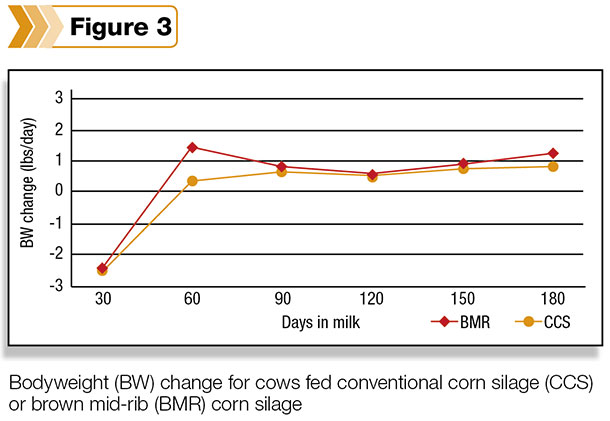Reaching high peak milk production is key to a successful lactation. Each 1-pound increase in peak milk translates into 213 to 304 pounds more milk throughout the entire lactation. Unfortunately, a cow’s inability to increase dry matter intake during the first weeks after calving can prevent the cow from reaching high peak milk production. The challenge is even greater when rations contain high levels of forage that is not easy to digest.
High-forage rations in early lactation
Dairy producers are adding more corn silage to rations as a forage source. In some cases, forage makes up 60 percent or more of dry matter. As cows consume more forage, the corresponding rumen fill can limit dry matter intake. This can be problematic in early lactation, when high intake is critical.
One solution is to feed highly digestible forages that pass through the rumen more quickly and allow cows to eat again soon. New research from Utah State University shows that feeding highly digestible BMR corn silage to cows in early lactation can increase dry matter intake and achieve higher peak milk production.
Comparing fresh-cow diets
Beginning at calving and continuing for 180 days, researchers fed one group of Holsteins a ration containing BMR corn silage from a hybrid with the bm3 gene mutation.
Another fresh group received conventional (non-BMR) corn silage. Neutral-detergent fiber digestibility (30 hours in vitro) for the BMR corn silage was 71.4 percent – 9.2 percentage points higher than the conventional corn silage.
All diets were formulated to maintain a forage-to-concentrate ratio of 60-to-40. Except for the corn silage hybrid, all other ration ingredients were the same.
The total mixed ration incorporated alfalfa hay, flaked corn, dried distillers grains, soybean meal and whole cottonseed. Corn silage made up 35.1 percent of the ration dry matter, and alfalfa hay made up 24.8 percent.
Higher intake, more milk
At the start of lactation, a dairy cow’s energy requirements suddenly increase. Feed intake drops at this time, so the cow gets less energy than she needs to keep up with her production demands. This inequity between the energy the cow consumes and the energy needed for production is called negative energy balance (NEB). The Utah State researchers’ goal was to overcome NEB with the highly digestible BMR corn silage ration.
For the first 180 days of lactation, researchers compared dry matter intake, milk production and weight loss of both groups of cows.
Dry matter intake after peak milk was higher for the BMR-fed cows. As cows recover from NEB, dry matter intake is controlled less by oxidation of fuels in the liver and more by ruminal distension. The Utah State results show that feeding highly digestible diets during this stage of lactation allows for higher dry matter intake ( Figure 1 ).

Higher feed intake translated into higher milk yield at peak lactation, and the production advantage persisted through the first 180 days in milk. Cows fed the BMR corn silage diet produced an average of 2 pounds more energy-corrected milk per cow per day compared with those on the conventional corn silage diet ( Figure 2 ).

Less weight loss
Cows fed BMR corn silage maintained better body condition in the first 60 days of lactation. Cows were weighed at 30-day intervals. Those fed BMR lost less than half a pound of bodyweight per day from day 1 to 60, compared with more than a pound per day of bodyweight loss for those fed the conventional corn silage ration. After 90 days, there were no differences in bodyweight among the cows ( Figure 3 ).

Overcoming NEB
The Utah State University research reinforces what many dairy producers have seen in their herds: The high digestibility of BMR corn silage allows cows to take in more feed and lessen the effects of NEB.
Cows affected by NEB move body fat reserves to compensate for lost energy. The amount of fat a cow moves depends on the change in her hormones and the responsiveness of her tissues to these hormones. The more fat a cow mobilizes, the less feed she takes in.
That’s why keeping cows eating is an important goal during the transition period – not only to improve milk production but also to reduce the risk of fatty liver, ketosis and fertility problems later in lactation.
Feeding BMR corn silage in high- forage diets can decrease weight loss in fresh cows, without limiting dry matter intake around peak lactation. This results in higher peak milk and greater lactation persistency. PD
Kathleen Emery is a dairy veterinarian and practiced in Wisconsin for 11 years. Dr. Emery completed a Food Animal Production Medicine Residency at the UW – SVM in 2002. Since 2006, she has been employed by Dow AgroSciences providing technical nutritional support for the silage business in Wisconsin and Iowa.
References omitted due to space but are available upon request. Click here to email an editor.

Kathleen Emery
Dairy Nutritionist
Mycogen Seeds






